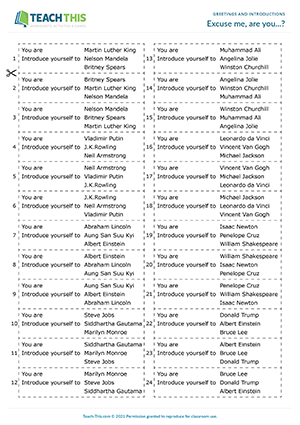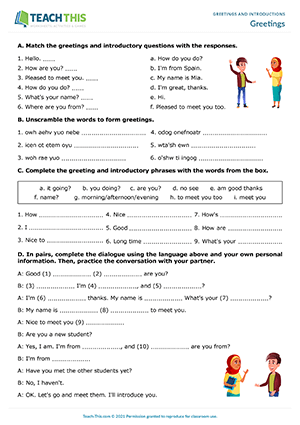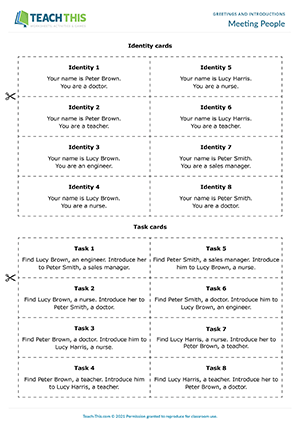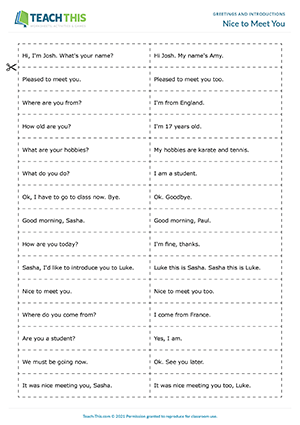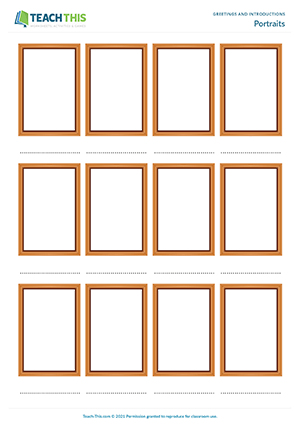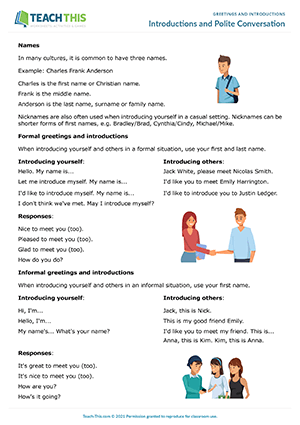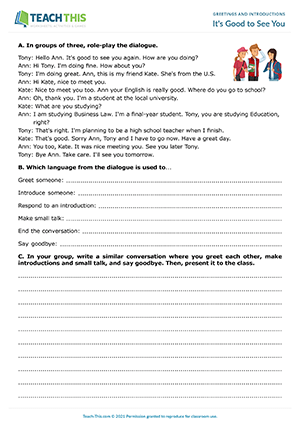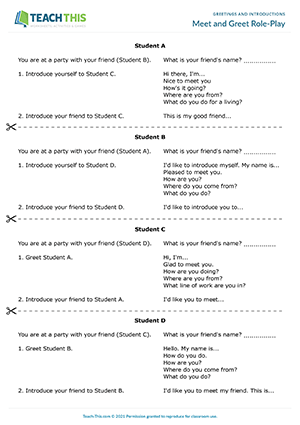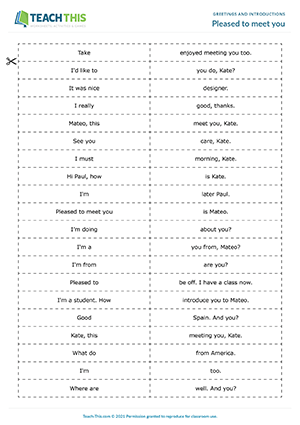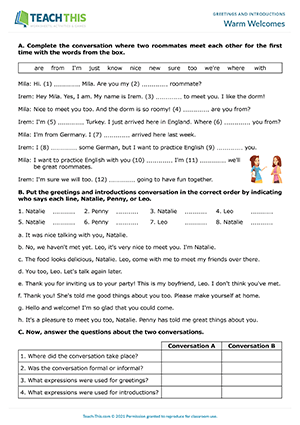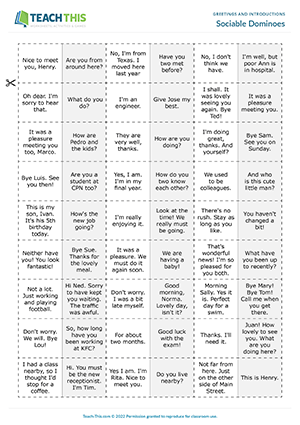In this engaging introducing yourself speaking activity, students find two famous people and introduce themselves as another famous person. Students take on the role of the famous person marked on their card. Their task is to find and introduce themselves to the two other famous people shown on the card. Students move around the class and ask one another Excuse me, are you...? questions. If the person is not who they are looking for, students say Sorry and move on to speak to someone else. If it is one of the people they are looking for, students introduce themselves by saying 'Hello, I'm... Nice to meet you'. Other phrases are also possible such as Let me introduce myself, Pleased to meet you, etc. When the students have found and introduced themselves to the two famous people on their cards, they sit down. Afterwards, students repeat the activity with different cards or tell the class who they met.
In this useful greetings worksheet, students learn and practice language for greeting people. Students begin by matching greetings and questions with responses. Students then unscramble words to make greetings. Next, students complete greeting and introduction expressions with words from a box. After that, in pairs, students practice the expressions by completing a dialogue using the language from the worksheet and their own personal information. Students then practice the conversation with their partner and present their dialogue to the class.
Here is a free introducing yourself and others speaking activity to help students practice greetings and introducing themselves and others. Students take on the identity of the person on their card. Their task is to find the two people on their task card and introduce them to each other. All the names and jobs are very similar, so students need to listen carefully to make sure they have the right two people. Students go around their group introducing themselves and asking each other's name and job until they find the two people who are to be introduced. When a student finds the two people, they introduce them to each other using the target language.
This productive greetings and introductions game is ideal for introducing phrases for greetings, making introductions and saying goodbye. In pairs, students take it in turns to turn over two cards. If the greetings and introductions language on the cards match, the student says the two lines aloud and keeps the cards. If the two cards don't match, the student turns them back over. The student with the most cards at the end of the game wins. Next, students spread the cards out face-up and read them, matching them together to make two dialogues.
Here is a fun introducing yourself speaking activity to help students introduce themselves and find out each other's names on the first day of class. Students begin by randomly drawing a portrait of themselves in one of the picture frames on the worksheet. Students then pass their worksheet to the person on their right who draws themselves anywhere on the worksheet and passes the sheet to the person on their right. This process is repeated until students receive the worksheet they started with, complete with pictures in every frame. Finally, students go around the group identifying their classmates from the portraits, finding out their names and introducing themselves.
In this comprehensive introductions and polite conversation worksheet, students learn and practice formal and informal phrases for greetings, making introductions, polite conversation and saying goodbye. Students start by learning formal and informal language for greeting someone and making introductions. Students then move on to learn how to make polite conversation, end a conversation and say goodbye. In groups, students then use the language they have learnt to create a formal conversation where they greet each other, make introductions and polite conversation, and say goodbye. When the students have finished, they repeat the conversation in an informal setting. Finally, students present their dialogues to the class.
This enjoyable greetings and introductions role-play helps students to learn and practice language for greetings, making introductions, small talk and ending a conversation. In groups, students role-play a dialogue from the worksheet. Students then write down the language that was used in the conversation to greet someone, introduce someone, make small talk, end the conversation and say goodbye. Students also suggest other possible phrases for each function. In their groups, students then write a similar dialogue where they greet each other, make introductions and small talk, and say goodbye. These dialogues are then presented to the class.
This communicative greetings and introductions role-play helps to teach students various formal and informal phrases for greetings and introductions. In two pairs, students write their partner's name on a card. Each student then greets or introduces themselves to a student in the other pair using introductory phrases on their card. After students have introduced themselves, they ask follow-up questions from the card and get to know each other. Students then introduce their friend to the person they are speaking to using a given phrase. Afterwards, students swap roles and repeat the activity to give them practice at using the other introductory phrases. Finally, groups act out their role-plays in front of the class.
Here is an entertaining greetings and making introductions game to help students practice or review formal and informal phrases for greetings, making introductions and saying goodbye. In groups of three, students take it in turns to turn over two cards. The aim of the game is to find the beginning and ending of a phrase for greeting, introducing or saying goodbye. If a student matches a beginning and ending successfully, they say the phrase aloud, keep the cards and have another turn. If the two cards don't match, they are turned back over and it's the next student's turn to play. The student with the most cards at the end of the game wins. Students then sort the cards into a conversation between three people. When the students have done this, they take on the role of the three people in the conversation and role-play the dialogue together. Lastly, students say which phrases they think are formal and informal and suggest other language that could be used in the conversation.
This insightful greetings and introductions worksheet helps students to learn language for greetings and introductions in different settings. Students start with a gap-fill exercise where they complete a conversation in which two roommates meet each other for the first time. Next, students read lines from a conversation where three people greet each other and make introductions at a party. Students then put the conversation in order by indicating who says each line. Afterwards, students answer questions based on the two conversations. As an extension, students create their own greetings and introductions conversation using the language from the worksheet.
In this rewarding greetings and introductions game, students match language for greetings, introductions and saying goodbye with suitable responses. The first player puts down one of their dominoes on either side of the domino on the table, making sure that the language matches with a suitable response. The players then take it in turns to match their dominoes in the same way by putting a domino down at either end of the domino chain. If a player is unable to put down one of their dominoes, they take one from the top of the pile and put it down if they can. If there are no dominoes left in the pile, play passes to the next student. The first player to get rid of all their dominoes wins the game.
Latest Free
Resources
- Everyday Objects Bingo
Everyday Objects
Elementary (A1-A2)
- Action Verb Races
Actions
Elementary (A1-A2)
- Birthday Basics
Birthdays
Elementary (A1-A2)
- Sales Phrasal Verbs
Business Phrasal Verbs
Upper-intermediate (B2)
Latest Member
Resources
- Collocations at Work
Business Collocations
Intermediate (B1)
- Etiquette Trivia Board Game
Etiquette and Manners
Upper-intermediate (B2)
- Everyday Objects Vocabulary
Everyday Objects
Pre-intermediate (A2)
- Let's have a talk
Verb-Noun Collocations
Pre-intermediate (A2)



